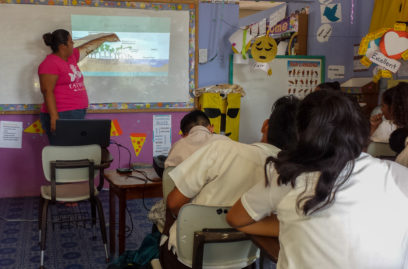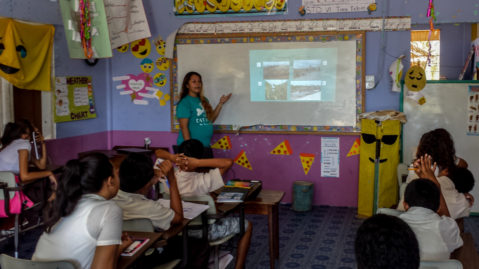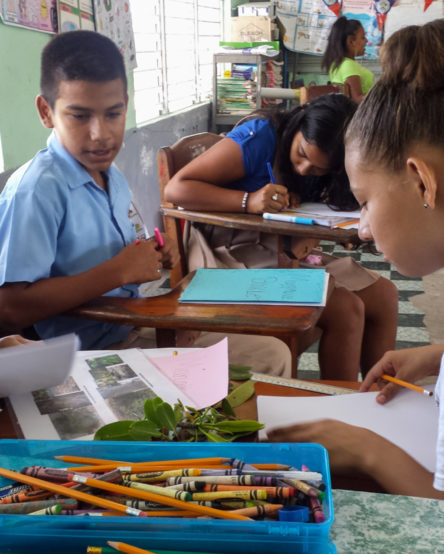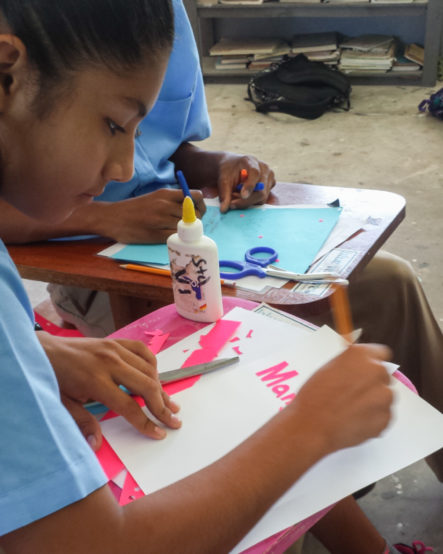I remember walking along the coast when I was ten years old, and seeing mangroves covering the shore and the shallows. At that tender age, when I swam in the sea and saw the mangroves underwater, I was afraid. Those dark entangled roots covered in algae and the shadows of unknown animals swimming past gave me the chills. I remember asking my mom why people didn’t cut them down and remove them from the swimming area.
Now, almost 20 years later, I find myself entering a classroom in my hometown of Sarteneja, a fishing village on the coast of Belize, about to give a lesson to primary school students on the importance of mangrove ecosystems. I am the Education and Outreach Assistant in Blue Ventures’ Belize team, and part of my role includes offering mangrove lessons to both of the primary schools in Sarteneja.
Discover Blue Ventures’ integrated approach to community-led mangrove management in Madagascar
My knowledge of mangroves has expanded since my youth, and I can now see how important they are to Belize and to my community. These salt-tolerant trees serve as nursery sites for several valuable fish species, and fishing is the main source of income in Sarteneja. The livelihoods of my community depend on these ecosystems. They also protect both the land from storm surges and the Belize Barrier Reef from sedimentation.
Despite these benefits, mangroves are threatened by a number of anthropogenic factors including deforestation for land development or construction, and climate change. We are negatively affecting mangroves and therefore we must also be part of the solution, and be the ones to protect mangroves.
As I entered the classroom with Darling Ortega, Blue Ventures’ Community Conservation Leader, we were politely greeted by the students and I felt a wave of relief run over me, chasing away the nervousness I had been feeling. My background is in education, and I have previously been a teacher, but you never know what a class of 12-14 year olds is going to be like. I needn’t have worried though, this class was wonderfully attentive and engaged, increasing my confidence and even making me miss my teaching days!
The four species of mangrove found in Belize are the red mangrove Rhizophora mangle, the black mangrove Avicennia germinans, the white mangrove Laguncularia racemosa and the buttonwood mangrove Conocarpus erectus
The first half of the day was spent improving the students’ knowledge of mangroves through presentations and discussion. The students learnt about the four mangrove species found in Belize, how to identify each one, the threats these mangroves are facing, and their ecologic and economic importance.
In the second half of the day, the students had the opportunity to get their creative groove on and make their own mangrove identification booklet. We passed around samples of leaves, flowers, seeds, and fruits from each mangrove species to help inspire the students, and the resulting booklets were really stunning. There are a lot of talented young artists in Sarteneja! We also found that the students who had been struggling to remember more scientific words like ‘pneumatophores’ and ‘propagule’ found this visual form of learning much more helpful, and it helped bring mangroves alive for them.
As someone who didn’t realise the importance and benefits of mangroves until later in life, I feel that teaching kids about mangroves at a young age is very important. Through more educational days like this, we hope to spread the word about mangroves to the youth of Sarteneja, and hopefully encourage them to take part in mangrove conservation efforts in the future. Our community is highly dependent on mangroves, so we need to protect them so that they can continue to provide for us. Conserving mangroves is a win-win situation, don’t you think so too?
Read more from our education and outreach team in Belize: Sarteneja’s kids learn about marine conservation through art





